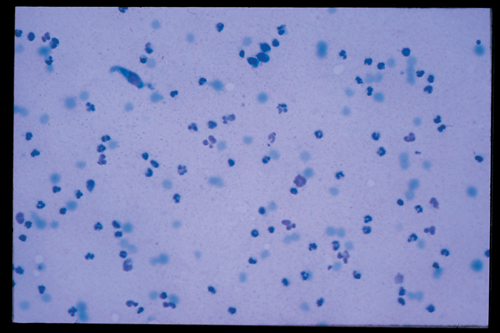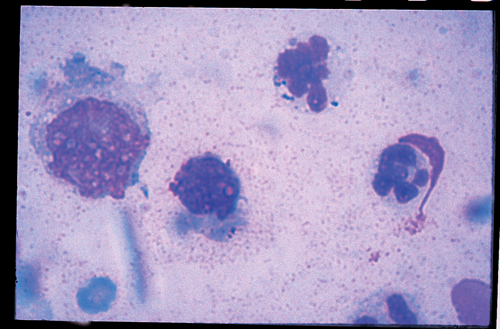Small Animal Orthopaedics Q&A 15
| This question was provided by Manson Publishing as part of the OVAL Project. See more Small Animal Orthopaedics Q&A. |
A ×16 and a ×100 photograph of Wright–Giemsa stained cytologic preparations of synovial fluid aspirated from the stifle joint of a five-year-old, neutered female Old English Sheepdog.
| Question | Answer | Article | |
| Describe the cytologic features seen on these slides. | Degenerate neutrophils are present in large numbers. A few mononuclear cells and synoviocytes can also be seen. Phagocytosed cocci are present within a degenerate neutrophil and macrophage when the slide is examined under high power (×100 objective). |
Link to Article | |
| What is the most likely diagnosis? | Septic arthritis |
Link to Article | |
| What specific diagnostic technique will yield the best chance of a definitive diagnosis? | Although the presence of large numbers of neutrophils in the synovial fluid is suggestive of septic arthritis, immune-mediated arthropathies must also be considered, particularly if neutrophils are non-degenerate. The presence of bacteria in the synovial fluid in this dog substantiates the diagnosis of septic arthritis; however, many cases of septic arthritis will not have obvious bacteria present on microscopic examination of the synovial fluid. In most cases, culture of synovial fluid is critical to a diagnosis of septic arthritis; however, approximately 50% of synovial fluid cultures from infected joints will initially yield false-negative results. Inoculating synovial fluid into blood culture medium and incubating for 24 hours (37°C/98.6°F), followed by inoculation onto blood agar, significantly increases the possibility of obtaining positive cultures. It is recommended that synovial fluid samples be inoculated onto an aerobic culturette as well as into blood culture medium. The aerobic culturette can be cultured immediately while the sample in the blood culture medium can be subcultured after 24 hours if the culturette sample has yielded no growth. Synovial fluid is as or more likely to yield positive cultures than synovial membrane samples if this protocol is followed. |
Link to Article | |
| What general mechanisms are responsible for the development of this condition? | Joint infections can be initiated by hematogenous spread of bacterial organisms to the joint from a remote site of infection, extension of a local (juxta-articular) infection into the joint or traumatic penetration of the joint. Joints may also be infected iatrogenically as a result of articular surgery or intra-articular injections. The most common organisms isolated from infected joints in dogs and cats include Staphylococcus spp., Streptococcus spp., Corynebacterium spp., Escherichia coli and other coliforms. |
Link to Article | |

